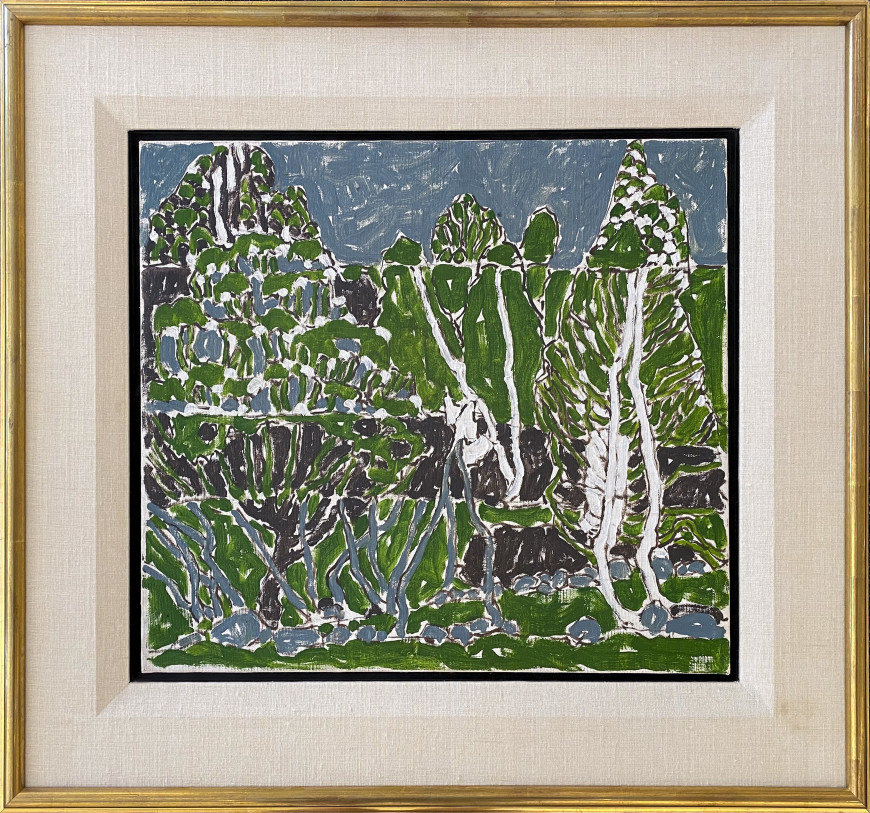-
Artworks
David MilneTree Pattern (Boston Corners, N.Y.), 1916 (May-June)1881-1953Oil on canvas17 7/8 x 19 7/8 in
45.5 x 50.5 cm
This work is included in the David B. Milne Catalogue Raisonne of the Paintings compiled by David Milne Jr. and David P. Silcox, Vol. 1, no. 107.7.SoldInscriptions
inscribed [by Duncan], ‘<1916> / 1915 // <1915>’ (verso); inscribed [by the Duncan estate], 719 (verso) This work is included in the David B. Milne Catalogue Raisonne of the Paintings compiled by David Milne Jr. and David P. Silcox, Vol. 1, no. 107.7.Provenance
Mira Godard Gallery, 1995.
Acquired from above by present Private Collection, Montreal, 1995.
Exhibitions
Toronto, Mira Godard Gallery, David Milne 1882-1953: Bright Garden, 18 October - 5 November 1986, as Intercepting Trees, 1915;
Montreal, Galerie Walter Klinkhoff, 15-29 September 2001, David Milne (1882-1953) Retrospective Exhibition, cat. no. 14.
Literature
Mira Godard Gallery, Toronto, David Milne 1882-1953: "Bright Garden", 18 October - 5 November 1986, as Intercepting Trees, 1915, repr. in colour p 13 as Intercepting Trees, 1915;
David Milne Jr. and David P. Silcox, David B. Milne: Catalogue Raisonné of the Paintings Volume 1: 1882-1928, (Toronto: University of Toronto Press, 1998), no. 107.7, repr. p. 162.After a culturally intense and professionally successful period in New York City – from his student days at the famed Art Students’ League (1903-05) through his early career – in the spring of 1916 David and Patsy Milne moved from Manhattan to the village of Boston Corners in rural New York, population 96 at the time. The Berkshire Mountains of the region provided picturesque terrain mixed with the domestic elements of farms and small settlements. A rail line connected Milne to the metropolis, but his concern was with his immediate surroundings. While on the one hand it would seem to be a large change and challenge to move from urban motifs, often large buildings in New York, to variations on more open and also densely forested landscapes, there were (as one might also expect) continuities between Milne’s assured manner of depicting Manhattan and his new themes around Boston Corners. The visual concentration and palpable energy of Tree Pattern (Boston Corners, N.Y.) is an extension of his later New York work. For example, Store Fronts of 1914-15 [private collection] demonstrates Milne’s skill at showing motifs close up and promoting their interlocking patterns of colour and form (fig. 1). In New York, it is the low-rise buildings, stacked up with rectilinear walls and windows, that contrast appealingly with Milne’s interspersed tree forms. Tree Pattern speaks the same language in completely organic form.
How does Milne build such a strong surface pattern in this Boston Corners painting yet maintain its legibility as a hillside, an evocation of nature, not an abstract decoration? For one thing, the densely marked surface ‘breathes’ easily because Milne applies generous amounts of white pigment in varying weights to lighten the predominant forms articulated in black, slate blue, and green. Where in later work such as Ruin in the Wood or Bear Camp V, above, he would leave such white areas literally blank, the effect here remains one of elasticity in the overall image. The sinewy tree forms are allowed to move to form patterns for us, rather than being locked into a mosaic. The bold colours and paint application make this painting dramatic. In addition, it presents a strong pull between the horizontal and vertical (we might even say between the ‘landscape’ and ‘portrait’ formats). If we look at how Milne has painted the full-canopied deciduous tree that dominates the left portion of the canvas, for example, we see that the form has its black trunk and lower boughs firmly planted. As it rises, however, the black gives way to more green and especially to blue and white intimations of foliage with sky beyond. At the top of the painting, black is used sparingly to suggest hillside and the bases of yet more trees, now distant.
While this progression of form and colour is itself remarkable, Milne adds to the complexity of the picture by emphasizing in turn its horizontality. Again moving from ground level up, we see bands of form and colour moving across and behind the trees, which point skywards. Black forms to the right in the bottom layer suggest boulders, but higher up, they simply connote background hillsides. Higher and deeper in space still are a predominantly green band suggesting treetops, and the sky, in which Milne vigorously deploys the same blue hue that he has scattered across the entire surface. Milne’s restricted if bold palette in this Boston Corners painting is very much like his later New York work, however different the subject matter. The painting is not insistently horizontal, vertical, or rectilinear. It is a tour de force of pattern that is also a recognizable and individualized landscape motif.
Tree Pattern (Boston Corners, N.Y.) sets up questions that we might pose to Milne’s work as a whole and indeed to painting under the auspices of Modernity. Pattern, surface, texture, colour – the array of ‘formal’ qualities – are clearly important to Milne, as he wrote in the passage cited at the outset of this essay. Looking at nature, I see “one of my own pictures, a little different from ones done before, changed slightly, very slightly, by what I saw before me." Yet he also moved many times and discovered new subjects – urban scenes, portraits, buildings, and thickets of woods – all of which are decidedly individual and identifiable as parts of their locales. Milne’s art reminds us that we do not need to choose between what we might call these different focal lengths in art but instead see them as collaborative, most effectively in new artwork.
Mark A. Cheetham
_________
David P. Silcox, Painting Place: The Life and Work of David Milne, University of Toronto Press, 1996: 70.











